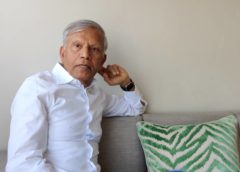
There’s an air of primness about Dilip Doshi’s personality. Be it on the field or off it, he was, and is, always immaculately dressed. It is this attribute of primness, coupled with a sharp, analytical mind that has helped him win a number of friends across different spheres all the world over.
That Doshi didn’t get to make his Test debut for India before the age of thirty-one—despite having plied his trade with the Nottinghamshire CCC first team before that—only goes to show how miserable the state of affairs were for the non-Bombay and non-Delhi players once upon a time. It is, in fact, one of the saddest stories of Indian cricket that a player as efficient and respected as him was hobbled and cornered for no other reason than for having played the game in the same era as that of a certain Bishan Singh Bedi: the sole left-arm spinner in the national side for over a decade (1966-79) who was reluctant to have any competitor breathing down his neck. Rajinder Goel and Padmakar Shivalkar—two of the finest practitioners of left-arm spin during that era—were two other casualties of such monopolistic selection practices. Unlike Doshi though, they were never given the opportunity to don the Indian Test cap.
As a left-arm spinner, Doshi never turned the ball by a mile. He didn’t have to. An imitable action off a couple of paces and his mastery over flight and control were enough to fetch him 114 Test wickets besides another 784 scalps from 205 other first-class matches. Once he bade farewell to the sport he considers the ‘’greatest of games’’ in 1986, he made the rather uncanny transition from being a top-class cricketer to being an entrepreneur of high repute.
Doshi, who has had his business operations centred in London since his retirement from professional cricket three decades ago, spoke exclusively to cricfit.com correspondent Ritam Basu during the lunch break on Day 3 of the Southampton Test between England and India from his Mumbai residence.
Q: With the rough patches on the track having already come into play on Day 3, do you think batting will get more and more difficult as the game wears on?
Doshi: Yes, definitely.
Q: What should be a safe target for India to chase in the fourth innings, given the fact that the opposition will be operating with two spinners?
Doshi: Anything within 200.
Q: What did you make of Moeen Ali’s bowling in the first innings?
Doshi: Oh, Moeen is a very good bowler! He bowled really well in the first innings, keeping things tight. He has, in fact, bowled better than our off-spinner.
Q: What has been your assessment of the way Ashwin has bowled in this game so far?
Doshi: Ashwin has bowled very poorly. I still think Jadeja should have been picked ahead of him for this game.
Q: Over the last couple of years, Indian batsmen haven’t fared particularly well against finger spinners in Test cricket. What according to you is the reason behind this?
Doshi: First of all, what makes you think that Indian batsmen should not be getting out to finger spinners? It’s like suggesting that Australians/South Africans/New Zealanders shouldn’t be getting out to our seamers. But that’s not the case. Anybody bowling well is bound to take wickets. I would rather say that the finger spinners in the opposition camps have bowled better than our finger spinners on many occasions and that’s why they have been successful.
Q: That our batsmen have struggled against spin in recent times—is it a reflection of the dearth of quality spinners on the Indian domestic circuit?
Doshi: Absolutely! The quality [of domestic spinners] has gone down by a mile. Many of these spinners wouldn’t even have got a look for the Test team had they been playing during my own playing days, but today they are permanent fixtures of the Test team because of the lack of overall quality.
Q: Michael Holding has been quite skeptical about Hardik Pandya’s role as an all-rounder in the Indian Test side. What are your views on the same? Do you think he has the ability to cement his place as a permanent fixture in the Test team?
Doshi: Well, he is a talented cricketer, but he has to put his head down and become much more consistent. He is definitely not consistent at the moment. There is no doubting his talent but talent is often not just enough. It has to translate into performance.
Q: In your autobiography ‘’Spin Punch’’, you have mentioned how Bishan Singh Bedi, the Chairman of Selectors—prior to your comeback Test against Pakistan in 1983 –had conspired to make the circumstances uncongenial for your comeback. Do you think things have become a lot better in Indian cricket today, both in terms of credibility and transparency?
Doshi: Indian cricket is truly Indian cricket today. Regional bias has been totally wiped out of the system, whereas in my times, people had vested power and interests.
Q: Do you think the Kohli-Shastri captain-coach duo has changed the face of Indian cricket, in terms of instilling a winning mentality that was not so common amongst the teams of the previous generations?
Doshi: I think there has been a massive change in the general outlook of the Indian team over the last fifteen years. The selection committee looks to reward talent today, irrespective of zones, which is how things should be. Nowadays, the team is being driven by a winning mentality which I really admire.
Q: Where would you place Kohli on the list of India’s finest captains?
Doshi: I think Kohli is still learning and the most impressive trait of his captaincy is that he has a fire in his belly. He is always looking to win, which is a great attribute to have as a captain. We’ve all seen how he encourages the entire team to lift their performance and by the time he finishes his career, I am sure that he will go down as one of the greatest captains India has ever produced.
Q: During your own playing days, there weren’t too many players who could consistently aid you and Kapil Dev in the bowling department. Would you say that this is India’s best-ever bowling attack, looking at the variety that it has?
Doshi: I haven’t seen a better Indian pace-bowling unit than this in the past. However, I can’t say the same about the spinners. I honestly believe that Ravindra Jadeja still has a lot to offer, and in some ways, it is disappointing that he hasn’t played regularly on overseas tours.
Q: Quality left-arm spinners have become a rarity on the Indian domestic circuit these days. What, in your opinion, are the reasons behind this slump of producing international standard left-arm spinners in India?
Doshi: I think they lack the hunger to succeed. If as a child a spinner dreams of becoming world-class, he will have to work very hard. Success is becoming instant. The gratification of playing at the highest level has become ephemeral. When you get such huge sums of money playing T20 cricket and hog the headlines by bowling just four overs in a game, your hunger for excellence dies down. Therefore, you see many open-chested spinners in India now. Harbhajan was an open-chested bowler, Ashwin is open-chested and I see many others who are open-chested. This is why I would have been happy to see Jadeja playing this game because he is a spinner of the classic mould. He could’ve made a difference.
Q: Who do you think is the best spinner in the world at the moment?
Doshi: It’s difficult to say. I don’t think it’s fair to rate anyone like that. Yasir Shah looks good and so does Nathan Lyon. In fact, I would say that Lyon is better than Ashwin on good pitches. Ashwin is an extremely good bowler on bad pitches, whereas Jadeja is more reliable on pitches that are not so conducive because he can keep things tight.
Q: In this age of T20 razzmatazz, do you really think it is necessary for a spinner to have a slew of variations in his inventory to succeed in every format?
Doshi: I can tell you one thing. As a spinner, you don’t need to have so many variations as people think you need to. It’s very, very difficult to master the art of control. The most important thing for a bowler is to become a master of length and line and that I don’t see today. The real test comes when you have to play on unhelpful surfaces because only then does one’s mastery come into play.
Q: Coming back to your autobiography, one can’t help but marvel at your soothsaying prowess. Your wish for a three-member national selection panel is a reality today and so are your calls for ensuring a system that would treat players and umpires alike with equal dignity. That the decision-making power of the Board has shifted from the elected members to the Committee of Administrators—has it made things better for Indian cricket?
Doshi: Well, I always believe that too many cooks spoil the broth. All we need is transparency; we don’t want a system where a West Zone selector would only back a West Zone player. Their (the national selectors’) primary duty is to look for and scout the talents in their respective zones but they must also be considerate and fair to talents from other zones. This is the reason why I had mentioned in my autobiography that having a three-member panel ensures greater neutrality and fairness in the system.
Q: Back to the Southampton Test. Has the game slipped out of India’s hands?
Doshi: The game is very delicately poised at the moment. England are already leading by 79 runs and as I said before, anything above 150 will not be easy to chase on this surface. I must add to this that we bowled very badly in the first innings after having them reeling at 92/4 at one stage, to put ourselves in this position. Despite the good work being done by the seam-bowlers, Ashwin has bowled rather poorly. I had expected him to do a lot better than he has done.













